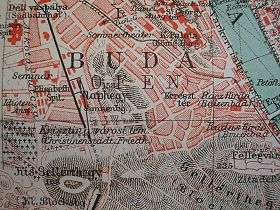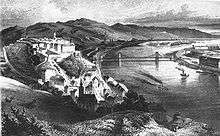Tabán
Tabán usually refers to an area within the 1st district of Budapest, the capital of Hungary. It lies on the Buda (i.e. Western) side of the Danube, to the south of György Dózsa Square, on the northern side of Elisabeth Bridge and to the east of Naphegy. Outside of Budapest, several other Hungarian cities and towns also have districts called Tabán.

History

The Tabán has been inhabited since Neolithic times, due to its location in a protected valley, the thermal waters at the bottom of the Gellért Hill and the ford over the Danube. In the Iron Age, it was inhabited by a tribe of Celts, who were replaced by the Romans in the 1st century BC.
In the Middle Ages, the Tabán was a village right under the Buda Castle. Remains of significant medieval structures were discovered by archaeologists in 1936. The Turks developed the thermal medicinal baths in the area and brought immigrants from the Balkans. The population increased after the liberation of Hungary from the Ottomans as refugees came from Greece, Bosnia and Serbia. The Franciscans from Bosnia established the parish church in the 17th century which still exists today and the Orthodox inhabitants established their own parish. The Church of Saint Demetrius was built in 1742-51 in Baroque style; it was the largest church building in the whole Metropolitanate of Karlovci. In the 18th century, the town was inhabited by Serbs, Greeks, Vlachs, Germans, Croats, Slovaks and Gypsies.
The history of Tabán is inseparable from that of the neighboring Naphegy and Gellérthegy districts. In the 19th century, the Tabán became known as a Bohemian quarter of Budapest with many restaurants, bars and bordellos. Its narrow streets on the hillsides echoed a Mediterranean atmosphere.
Kereszt Street was the center of old Tabán.
In the 1930s, the Tabán was demolished in order to facilitate urban planning in Budapest. Today, it is a park very popular with the population of the capital.
Topography
After the 1930 urban planning in Budapest, only a few old Tabán houses were left in the Naphegy district; one of them was the Tabán school, which was destroyed in January 1945, during the battle of Budapest. Today a sports field can be found where the school once stood. The only original streets remaining are Orom Street in Gellérthegy and Tabán Czakó Street in Naphegy.
Taban's historic and cultural attractions include a Memorial of the 1956 Hungarian Revolution near Naphegy Street and Kereszt Street and the Semmelweiss Orvostörténeti Múzeum near Apród Street.
Tabán in literature
The poet Dezső Kosztolányi wrote:
"Köröttem - esős akvarell - Tabán.
Nyugodt lennék itt s boldog is talán..."
"I crossed Tabán - a rainy watercolour.
I would be at peace here and maybe happy too..."
Gallery
.jpg) The old Tabán school was here, today sports field Naphegy near Czakó Street, Tabán-s historic places 1945 - 2003
The old Tabán school was here, today sports field Naphegy near Czakó Street, Tabán-s historic places 1945 - 2003.jpg) The last Tabán house; Czakó Street–Aladár Street in 2003, Tabán-s historic places 1945 - 2003
The last Tabán house; Czakó Street–Aladár Street in 2003, Tabán-s historic places 1945 - 2003 Tabán Springtime 2003, Tabán park today 2003 - 2004
Tabán Springtime 2003, Tabán park today 2003 - 2004 May 1. 2003, Tabán park today 2003 - 2004
May 1. 2003, Tabán park today 2003 - 2004 Memorial 1956 - 1956 Hungarian Revolution, Tabán park today 2003 - 2004
Memorial 1956 - 1956 Hungarian Revolution, Tabán park today 2003 - 2004 Playground, Naphegy utca - Hadnagy utca, Tabán park today 2003 - 2004
Playground, Naphegy utca - Hadnagy utca, Tabán park today 2003 - 2004
Sources
- Budapest Lexikon (Second edition, revised and expanded). 2 volumes. Akadémiai Kiadó, Budapest, 1993.
- Narodni Kalendar 1990, Aqua Kiadó és Nyomda, Budapest, 1990.
- Antal Szerb: Budapesti kalauz Marslakók számára (A Guide to Budapest for Martians)
See also
| Wikimedia Commons has media related to Tabán. |
The following are near Tabán:
- Gellert Hill
- Naphegy
- Krisztinaváros
- Buda Castle